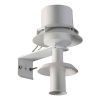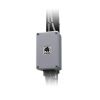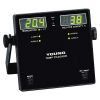YOUNG Humidity & Temperature Sensors
Features
- High accuracy, capacitance type humidity sensor
- Precision platinum RTD temperature sensor
- Junction box is provided for cable terminations
- Free ground shipping
- Expedited repair and warranty service
- Lifetime technical support
- More
Overview
The RM Young 41382 probe combines a high accuracy, capacitance-type humidity sensor and precision platinum RTD temperature sensor in one probe. The sensor is mounted in a weatherproof junction box for convenient wiring. Output options are available for 0-1 VDC, and 4-20mA.
Deployment
For accurate measurements, the RM Young 41382 relative humidity and temperature probe should be installed in a protective radiation shield. Use of the probe without a radiation shield may result in large errors due to solar heating. The probe installs easily in the Model 41003P naturally ventilated or Model 43502 aspirated shield.
Design
The relative humidity and temperature probe is designed to offer years of service with minimal maintenance. As with most humidity sensors, humidity calibration may drift slightly with time. Recalibration will restore the probe to acceptable limits.
- Output Signal: 0-1 VDC
- Power Required: 8 mA
- Temp Calibrated Measuring Range: -50 to 50 C
- Temp Response Time: 10 seconds (without filter)
- Temp Accuracy at 0 C: +/-0.3 C
- Temp Sensor Type: Platinum RTD
- RH Measuring Range: 0-100% RH
- RH Accuracy at 20 C: +/-2% RH,
- RH Stability: Better than +/-1% RH per year
- RH Response Time: 10 seconds (without filter)
- RH Sensor Type: Rotronic Hygromer
In The News
UNC's industry-standard water quality profiling platforms get upgrade
The University of North Carolina Institute Of Marine Sciences has a history with profiling platforms. UNC engineers and scientists have been building the research floaters for 10 years in a lab run by in Rick Luettich, director of the institute. UNC scientists and engineers developed their own autonomous vertical profilers to take water quality readings throughout the water column. They have three profilers placed in the New and Neuse rivers. The profilers are designed to drop a payload of sensors to an allotted depth at set time intervals. Instruments attached take readings continuously on the way down and up. Data collected by the profilers has been used to study water related issues such as infectious disease and sediment suspension.
Read MoreUSGS weather station network monitors Arctic Alaska's climate
When the U.S. Geological Survey began building their climate and permafrost monitoring network in Arctic Alaska in 1998, there wasn't much precedent for how to build the infrastructure for the instruments in the region's unforgiving environment. That meant the scientists had to learn the particulars on the fly. For example: On the great expanse of flat, barren tundra, a weather station sticks out like a sore thumb to a curious grizzly bear. "The initial stations were pretty fragile," said Frank Urban, a geologist with the USGS Geosciences and Environmental Change Science Center. "So the bear and those stations--the bear won every single time without any problem.
Read MoreFloating Global New Ideas: Buoy-Enabled Research at Florida Agricultural and Mechanical University’s School of the Environment
Florida Agricultural and Mechanical University (FAMU), based in Tallahassee, Florida, is the highest-rated public Historically Black College or University in the United States. FAMU’s School of the Environment (FAMU-SOE) offers BS and BA degrees in Environmental Studies, and BS, MS, and Ph.D. degrees in Environmental Science, with specialisms available in areas including Environmental Policy and Risk Management, Aquatic and Terrestrial Ecology, and Biomolecular Sciences. In 2021, FAMU-SOE deployed a NexSens CB-450 buoy in Apalachee Bay, a key oyster farming area around 30 miles south of Tallahassee. The buoy has quickly been incorporated into the curriculum, providing environmental insights for student research, the community, and beyond. Dr.
Read More

















